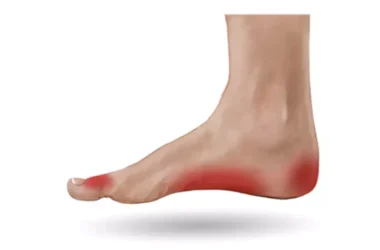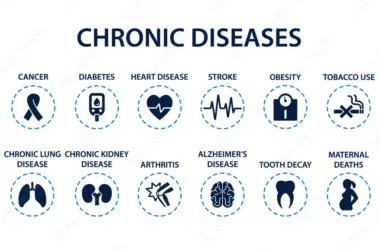Acanthosis Nigricans is a skin condition characterized by dark, thickened patches, usually found in body folds and creases.
These patches often appear in the armpits, neck, and groin areas. While Acanthosis Nigricans itself is not harmful, it can be an indicator of underlying health issues that require attention.
Understanding the symptoms, causes, and treatment options is crucial for managing this condition effectively.
Symptoms of Acanthosis Nigricans
Recognizing the Signs
The most common symptom of Acanthosis Nigricans is the appearance of dark, velvety patches on the skin. These patches may grow slowly and become more noticeable over time. Common areas affected include:
- Neck: Often the first and most noticeable area.
- Armpits: Another frequent location for these changes.
- Groin: Patches may also appear here, causing discomfort.
- Elbows, Knees, and Knuckles: In some cases, thickened skin can develop in these areas as well.
Additional Symptoms
Besides the visible changes, individuals may experience other symptoms such as:
- Itching: Affected areas can sometimes be itchy.
- Odor: In rare cases, the skin might emit an unusual odor.
- Skin Tags: Small, benign growths can develop in or around the patches.
Causes of Acanthosis Nigricans
Underlying Health Conditions
Acanthosis Nigricans is often a symptom of an underlying health issue. Here are the primary conditions that can lead to the development of this skin disorder:
- Insulin Resistance: This is the most common cause. When the body becomes resistant to insulin, it often leads to elevated insulin levels in the blood. High insulin levels can cause rapid skin cell growth, resulting in the dark, thick patches characteristic of Acanthosis Nigricans. This condition is frequently seen in people with type 2 diabetes and those who are overweight or obese.
- Hormonal Disorders: Various hormonal imbalances can contribute to Acanthosis Nigricans. Conditions such as polycystic ovary syndrome (PCOS), hypothyroidism, and Cushing’s syndrome can disrupt normal hormonal levels, which can, in turn, lead to skin changes.
- Cancer: Although rare, certain cancers, particularly those of the stomach, liver, and other internal organs, can cause Acanthosis Nigricans. When this skin condition appears suddenly and spreads quickly, it might indicate an underlying malignancy.
Medications and Supplements
Certain drugs and supplements have been linked to the development of Acanthosis Nigricans. These include:
- Steroids: Prolonged use of systemic corticosteroids can trigger skin changes.
- Hormonal Treatments: Medications such as contraceptives and those used in growth hormone therapy can influence skin pigmentation and texture.
- High-Dose Niacin: Large amounts of niacin, a B vitamin, can sometimes lead to Acanthosis Nigricans.
Genetic Factors
There is also a genetic component to Acanthosis Nigricans. Some people inherit a predisposition to develop this skin condition.
This genetic form often appears during childhood or adolescence and is usually not associated with other health issues.
Obesity
Obesity is a significant risk factor for Acanthosis Nigricans. Excess body weight can lead to insulin resistance, which is a primary cause of the condition.
The skin folds and creases of overweight individuals are more prone to the development of the thickened, dark patches associated with Acanthosis Nigricans.
Endocrine Disorders
Besides insulin resistance and obesity-related causes, other endocrine disorders can play a role.
Conditions affecting the adrenal glands, pituitary gland, and thyroid can alter hormonal balance, contributing to the skin changes seen in Acanthosis Nigricans.
Also Read: Understanding Jaundice: Causes, Symptoms, and Treatments
Understanding these causes is crucial for diagnosing and treating Acanthosis Nigricans effectively. By addressing the underlying issues, individuals can often improve their skin condition and overall health.
Diagnosing Acanthosis Nigricans
Diagnosing Acanthosis Nigricans involves a combination of medical history, physical examination, and additional tests to determine the underlying cause of the skin condition. Here is a detailed look at the diagnostic process:
Medical History and Physical Examination
Initial Consultation:
- During the initial visit, the healthcare provider will take a detailed medical history. This includes asking about any symptoms, duration of the skin changes, and whether there have been any recent changes in health or medications.
- The doctor will also inquire about family history, as genetic factors can play a role in Acanthosis Nigricans.
Physical Examination:
- A thorough physical examination focuses on the skin changes characteristic of Acanthosis Nigricans. The doctor will inspect the affected areas, noting the appearance, color, and thickness of the patches.
- Common sites of examination include the neck, armpits, groin, elbows, knees, and knuckles.
Additional Tests
If the cause of Acanthosis Nigricans is not immediately apparent from the medical history and physical examination, further testing may be necessary.
These tests help identify underlying health conditions that might be contributing to the skin changes.
Blood Tests:
- Fasting Blood Sugar and Insulin Levels: These tests help determine if there is insulin resistance or diabetes, which are common causes of Acanthosis Nigricans.
- Lipid Profile: Abnormal cholesterol levels can be associated with metabolic syndrome, another potential underlying cause.
- Hormonal Levels: Tests to measure levels of thyroid, adrenal, and reproductive hormones can help identify endocrine disorders.
Biopsy:
- In rare cases, if the diagnosis is uncertain, a skin biopsy may be performed. This involves taking a small sample of the affected skin for microscopic examination. The biopsy helps rule out other skin conditions that might mimic Acanthosis Nigricans.
Imaging Studies:
- If there is a suspicion of an internal malignancy (cancer), imaging studies such as X-rays, CT scans, or MRI may be ordered to check for tumors or other abnormalities.
Other Specialized Tests:
- Depending on the individual case, additional tests may be conducted to evaluate specific health concerns. For example, if an endocrine disorder is suspected, more comprehensive hormonal assessments may be needed.
Referral to Specialists
In some cases, the primary care physician may refer the patient to a specialist for further evaluation and management:
- Endocrinologist: For hormonal imbalances or diabetes management.
- Dermatologist: For specialized skin care and treatment options.
- Oncologist: If there is a concern about an underlying cancer.
Monitoring and Follow-Up
Once a diagnosis is made, ongoing monitoring and follow-up are essential. This helps ensure that the underlying condition is managed effectively and allows for adjustments in treatment as needed.
Regular check-ups can also track the progress of skin changes and the effectiveness of interventions.
By thoroughly diagnosing Acanthosis Nigricans and identifying its underlying causes, healthcare providers can develop a targeted treatment plan that addresses both the skin condition and any associated health issues.
Treatment Options for Acanthosis Nigricans
Treating Acanthosis Nigricans involves addressing both the skin condition and its underlying causes.
Effective treatment can improve the appearance of the skin and manage any associated health issues. Here are the main approaches to treatment:
Addressing the Underlying Cause
The first step in treating Acanthosis Nigricans is to identify and manage the underlying condition that is contributing to the skin changes.
Weight Loss:
- For individuals with obesity, losing weight can significantly improve the appearance of Acanthosis Nigricans. Weight loss helps reduce insulin resistance, which is a common cause of this condition.
Managing Diabetes:
- Controlling blood sugar levels is crucial for those with diabetes. This can be achieved through a combination of diet, exercise, and medication. Improved blood sugar control often leads to an improvement in skin symptoms.
Adjusting Medications:
- If a medication is causing Acanthosis Nigricans, a healthcare provider may recommend an alternative. This includes reviewing and potentially changing drugs such as steroids, contraceptives, or high-dose niacin.
Treating Hormonal Disorders:
- For conditions like polycystic ovary syndrome (PCOS), hypothyroidism, or Cushing’s syndrome, appropriate treatment to balance hormones can help reduce skin symptoms.
Topical Treatments
In addition to addressing the underlying causes, several topical treatments can help improve the appearance of the affected skin:
Retinoids:
- Topical retinoids, such as tretinoin, can help reduce the thickness and darkening of the skin. They work by promoting skin cell turnover and reducing pigmentation.
Keratolytic Creams:
- Creams containing salicylic acid, lactic acid, or urea can help exfoliate and smooth the skin. These agents help to break down the thickened skin layers.
Bleaching Creams:
- Creams containing ingredients like hydroquinone can help lighten the dark patches of skin. These should be used under the guidance of a healthcare provider to avoid potential side effects.
Moisturizers and Emollients:
- Regular use of moisturizers can help keep the skin soft and reduce irritation, which can be particularly helpful if the affected areas are prone to friction.
Cosmetic Procedures
For more severe cases of Acanthosis Nigricans, cosmetic procedures may be an option to improve the appearance of the skin:
Laser Therapy:
- Laser treatments can reduce pigmentation and thickness of the affected skin. Various types of lasers can target the melanin in the skin, helping to lighten the dark patches.
Dermabrasion:
- This procedure involves mechanically exfoliating the top layers of skin to promote the growth of new, healthier skin. Dermabrasion can be effective in reducing the appearance of thickened patches.
Chemical Peels:
- Chemical peels use acids to exfoliate the skin, helping to remove the outer layer and reduce pigmentation. This can be particularly useful for treating areas like the neck and armpits.
Lifestyle Changes
Making certain lifestyle changes can help manage and prevent Acanthosis Nigricans:
Healthy Diet:
- Adopting a balanced diet rich in fruits, vegetables, lean proteins, and whole grains can help manage weight and improve overall health. Avoiding processed foods and sugary drinks can also help control blood sugar levels.
Regular Exercise:
- Engaging in regular physical activity can help with weight loss and improve insulin sensitivity. Activities like walking, swimming, and cycling can be beneficial.
Routine Medical Check-ups:
- Regular visits to a healthcare provider can help monitor and manage any underlying conditions that might contribute to Acanthosis Nigricans. Early detection and management of these conditions can prevent the progression of skin changes.
Preventing Acanthosis Nigricans
Lifestyle Changes
Making certain lifestyle changes can help prevent or manage Acanthosis Nigricans. These include:
- Healthy Diet: Maintaining a balanced diet to manage weight and blood sugar levels.
- Regular Exercise: Physical activity can help prevent obesity and improve overall health.
- Routine Check-ups: Regular visits to the doctor can help in early detection and management of underlying conditions.
Avoiding Triggering Medications
Consult with healthcare providers about any medications or supplements that might contribute to the condition. Alternatives or adjusted dosages can sometimes mitigate the risk.
Conclusion
Acanthosis Nigricans, while not harmful on its own, often indicates an underlying health issue that needs attention.
By understanding its symptoms, causes, and treatment options, individuals can take proactive steps to manage their health and improve their skin condition.
Regular medical check-ups and a healthy lifestyle play crucial roles in preventing and managing this condition effectively.




